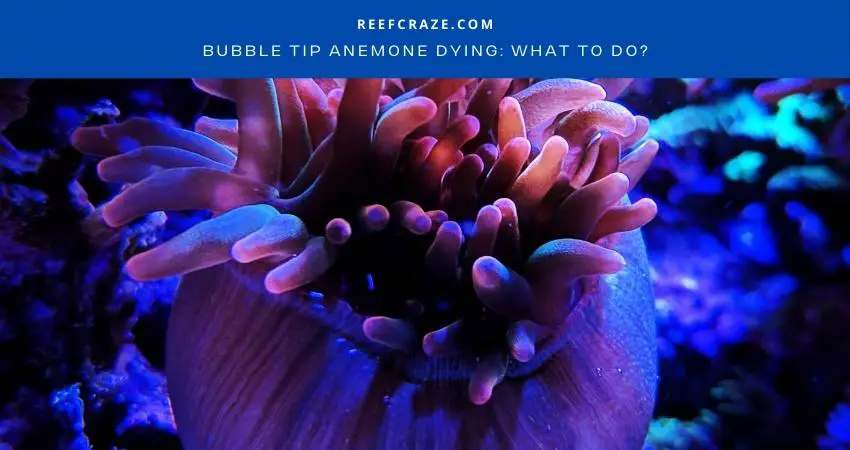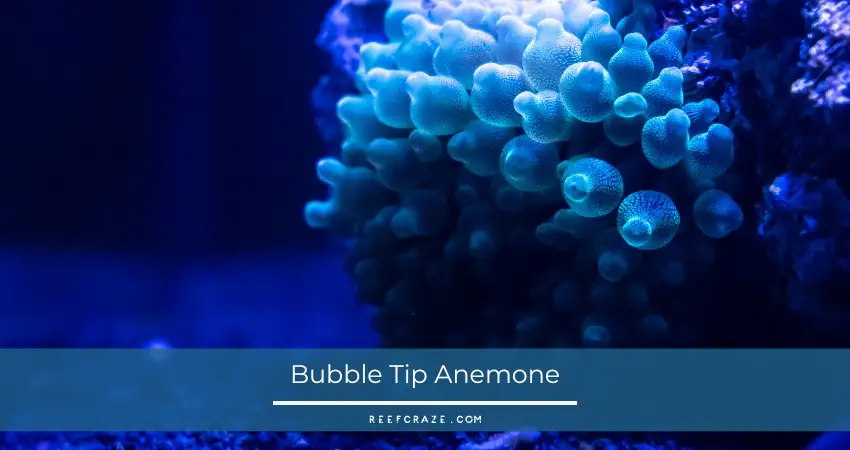If you find your bubble tip anemones shriveled up in your tank, you should be concerned about it. But do not jump to conclusions swiftly without thinking about what might have caused it. The first question is what factors are responsible for the bubble tip anemone dying.
A bubble tip anemone is naturally very sensitive, requiring high maintenance. It can die anytime if there is not adequate water acclimation or poor light conditions.
So, how do the factors affect them so much that they die? How can you make things right to keep your bubble tip anemone alive? I will answer all the relevant questions like these below.
What Factors Are Responsible For Bubble Tip Anemone Dying?
You can associate anemones and spineless animals with jellyfish, but not corals. Since they possess one organism for a colony, they do not require calcium shells like hard corals.
That makes bubble tips isolated organisms more vulnerable to changes than corals.
These anemones have the habit of roaming around a lot, which often gets them pushed on gyres or wavemakers. It can result in their death, magnifying the possibility of nuking the reef tank.
They will take a long time before finding their sweet spot. Once they do, they will swindle all the corals around their space.

Bubble tips can be pretty hostile and dominating toward the corals nearby. It is worse than how LPS corals die. So, when you arrange for your anemone to shift to a new place, you should prepare the nearby corals by making dispositions to keep them away. Make sure you do it within one or two days.
The anemones also require a decent amount of light in the SPS region of lighting with a 220-350 PAR value. Any rough deviation in the range will cause their demise.
Besides, anemones release an obnoxious smell into the tank after they are dead. It is so disgusting that it permeates the entire room with a sharp whiff.
NOTE
Many reefers make the mistake of paying no attention to the subtle stuff. Apart from lighting and water acclimation, if your aquarium size is not correct as per your bubble tips, they may die.
Above all, anemones require high solidity in a tank. The recommendation is you wait a minimum of 5 to 6 months before attaching one.
How To Save A Dying Anemone?
Since bubble tips are not resilient as other anemones, you have to give them an ideal and steady environment.

Now I will go over water flow, feeding, lighting, and other stuff to enhance your possibility of success.
Lighting Conditions
The anemones need high-output lighting. PC, LED lighting, a VHO set, a quality T5 fluorescent bulb, or metal halides.
They also need photosynthetic microorganisms like other invertebrates and anemones since it provides the necessary energy. Plus, elevated light keeps their color and health well-functioning.
The perfect light output for them is a volume between 220 PAR and 350 PAR. Do not forget that a BTA has a strong fluorescence vivid under blue LEDs or alchemical lighting.
Water Acclimation
You should follow appropriate acclimation after buying a bubble tip, and you need to do it before introducing it to your tank.
Here is the compulsory stuff for thriving anemone growth and acclimation:
- The water salinity or specific gravity should be between 1.023 and 1.025.
- You have to keep the water temperature between 25-degree Celsius and 28-degree Celsius (or 75-degree Fahrenheit and 82-degree Fahrenheit).
- For pH, it must be between 8.1 and 8.4.
These are the parameters you must maintain regularly by partial water changes. Otherwise, if there is any deviation in any criterion, it will pose a threat to your anemones.
Moreover, bubble tips prefer medium to high water flows within the aquarium. So, you should set it up with powerheads and pumps.
Feeding
Bubble tips and photosynthesizing microorganisms share a symbiotic relationship. The organisms take place at their center.
BTA’s get their energy from light, but they also need other proteins from meaty, small seafood like brine shrimp or mysis. Lucky for you, bubble tips are not picky about their food.
Depending on their sizes and activities, you should give food to your bubble tips once to thrice per week. You do not want to try different items because BTA’s usually do not prefer them.
If you see them breaking the food particles but not eating, they are not hungry. They may cling to it using their tentacles to eat later.
However, you need to clean any leftovers after one hour because crumbling food particles can poison the water, causing severe water quality issues.
So, you should check their behavior while they eat to understand if you should increase or decrease feeding frequency.
But if there are clownfish in your tank, you will not have to feed your anemones very often. That is because clownfish supplies anemones with food while also helping them breathe by themselves. Learn more about the symbiotic relation between clownfish and anemone.
Tank Placement
BTA’s are ambulant in nature, wandering around to meet their needs. You cannot expect your bubble tips to stay immobile as that is not their characteristic. They will lock their feet into any glass, solid exterior, or rock.
They will also shield pump overflows and intakes to keep themselves from being sucked up.
Note that your BTA will require powerful lighting to stay healthy. Your tank must have a minimum capacity of 30 gallons. An anemone cannot grow in an aquarium with lesser space.
Food Placement
You can get tank tongs to feed your anemones food. Do not use your hands. You might end up being stung.
I did not mean to scare you, though. Stings are lenient and rare if you are NOT allergic. The anemone will clutch at your hand and put it into its mouth until you take it out.
It is pleasing to see them come toward the food and take it. It will also be painless if you get a feeding stick.
How Do I Know If My Bubble Tip Anemone Is Dying?
Again, look at its mouth, the central part of its body neighbored by tentacles. If it is dying, it will invert its mouth and appear as if its insides are coming out.
Then observe its tentacles. If a bubble tip anemone looks deflated for a considerable amount of time, it is an indicator that your BTA is sick.
Frequently Asked Questions
Does A BTA Like Rock Or Sand?
Can A Bubble Tip Anemone Stay Next To Another?
Why Is My Bubble Tip Anemone Turning Brown?
Can A BTA Kill My Tank Fish?
How Can I Tell If My BTA Is Healthy?
Final Words
Bubble tip anemones are beautiful creatures, adding to the aesthetics of your reef tank. But mind that they require strict maintenance. If you think you cannot invest your time and labor into taking care of them, you should look into other easy-going anemones.
However, if you do decide to have bubble tip anemones, I am hoping yours will not die now that you know how to save a dying anemone.
Best of luck with that!
